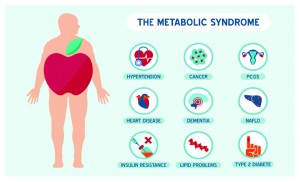By Susan Peacock MSRDN
 Your body lives by rules measured by numbers. Metabolic syndrome is the name for a group of risk factors that raises your risk for heart disease, diabetes and stroke.
Your body lives by rules measured by numbers. Metabolic syndrome is the name for a group of risk factors that raises your risk for heart disease, diabetes and stroke.
The term “metabolic” refers to the biochemical processes involved in the body’s normal functioning. Risk factors are traits, conditions, or habits that increase your chance of developing a disease.
Here you will find the healthy numbers the biochemical processes live by to maintain a healthy body. “Heart disease” refers to coronary heart disease (CHD). CHD is a condition in which a waxy substance called plaque builds up inside the coronary arteries.
Plaque hardens and narrows the arteries, reducing blood flow to your heart muscle. This can lead to chest pain, a heart attack, heart damage, or even death.
Metabolic Risk Factors
The five conditions described below are metabolic risk factors. You can have any one of these risk factors by itself, but they tend to occur together. You must have at least three metabolic risk factors to be diagnosed with metabolic syndrome.
• A large waistline. That would be 35” for women and 40” for men.This also is called abdominal obesity or “having an apple shape.” Excess fat in the stomach area is a greater risk factor for heart disease than excess fat in other parts of the body, such as on the hips.
• A high triglyceride level: 150 mg/dL or higher (or being on medicine to treat high triglycerides) is a metabolic risk factor. Triglycerides are a type of fat found in the blood. (The mg/dL is milligrams per deciliter—the units used to measure triglycerides, cholesterol, and blood sugar.)
• A low HDL cholesterol level (or you’re on medicine to treat low HDL cholesterol). HDL sometimes is called “Happy” cholesterol. This is because it helps remove cholesterol from your arteries.
A low HDL cholesterol level raises your risk for heart disease.An HDL cholesterol level of less than 50 mg/dL for women and less than 40 mg/dL for men is a metabolic risk factor.
• High blood pressure (or you’re on medicine to treat high blood pressure).
If this pressure rises and stays high over time, it can damage your heart and lead to plaque buildup.
A blood pressure of 130/85 mmHg or higher blood pressure is a metabolic risk factor.
If only one of your two blood pressure numbers is high, you’re still at risk for metabolic syndrome.
• High fasting blood sugar.
A normal fasting blood sugar level is less than 100 mg/dL. A fasting blood sugar level between 100–125 mg/dL is considered prediabetes. A fasting blood sugar level of 126 mg/dL or higher is considered diabetes.
A fasting blood sugar level of 100 mg/dL or higher (or being on medicine to treat high blood sugar) is a metabolic risk factor.
About 85 percent of people who have type 2 diabetes—the most common type of diabetes—also have metabolic syndrome.
These people have a much higher risk for heart disease than the 15 percent of people who have type 2 diabetes without metabolic syndrome.
• (If you are on medicine to treat high blood sugar). Mildly high blood sugar may be an early sign of diabetes.
Overview
Your risk for heart disease, diabetes, and stroke increases with the number of metabolic risk factors you have.
In general, a person who has metabolic syndrome is twice as likely to develop heart disease and five times as likely to develop diabetes as someone who doesn’t have metabolic syndrome.
Other risk factors such as smoking are major risk factors for heart disease but are not part of the metabolic syndrome.
Having even one risk factor raises your risk for heart disease. You should try to control every risk factor you can to reduce your risk.
The risk of having metabolic syndrome is closely linked to overweight and obesity and a lack of physical activity. Insulin resistance also may increase your risk for metabolic syndrome.
Your genetics and older age are other factors that may play a role in causing metabolic syndrome.
Outlook
Metabolic syndrome is becoming more common due to a rise in obesity rates among adults. The United States is 2nd in the world for obesity.
In the future, metabolic syndrome may overtake smoking as the leading risk factor for heart disease.
It is possible to prevent or delay metabolic syndrome, mainly with lifestyle changes. A healthy lifestyle is a lifelong commitment. Knowing the numbers your body lives by and living within those parameters will help you control metabolic syndrome.
WELLINGTON
1447 Medical Park Boulevard, Suite 101
Wellington, FL 33414
DELRAY
4600 Linton Boulevard, Suite 250
Delray Beach, FL 33445
MIAMI
8501 S.W. 124th Avenue, Suite 101
Miami, FL 33183
COCONUT CREEK
4848 Coconut Creek Parkway, Suite 200
Coconut Creek, FL 33063
STUART
789 South Federal Highway, Suite 102
Stuart, FL 34994
561-500-HOPE(4673)
www.weightlosshope.com
Check Also
WHAT IS MY CIRCADIAN RHYTHM AND WHY DOES IT MAKE ME FEEL SO “OFF”
By Renee Chillcott, LMHC Have you heard terms such as “biological clock” or “biorhythms”, or …
 South Florida Health and Wellness Magazine Health and Wellness Articles
South Florida Health and Wellness Magazine Health and Wellness Articles




